University of Sunderland Financial Management Assignment: APC308
VerifiedAdded on 2023/01/16
|16
|3907
|56
Homework Assignment
AI Summary
This financial management assignment analyzes key financial concepts and techniques. The first part evaluates equity finance options for Lexbel Plc, including right issues at different prices, and assesses the benefits and drawbacks of scrip dividends. The second part focuses on investment appraisal techniques for the Love-Well Ltd. Company, calculating payback period, accounting rate of return, net present value, and internal rate of return for a new machine purchase. The assignment provides detailed calculations and recommendations, offering a practical application of financial management principles.
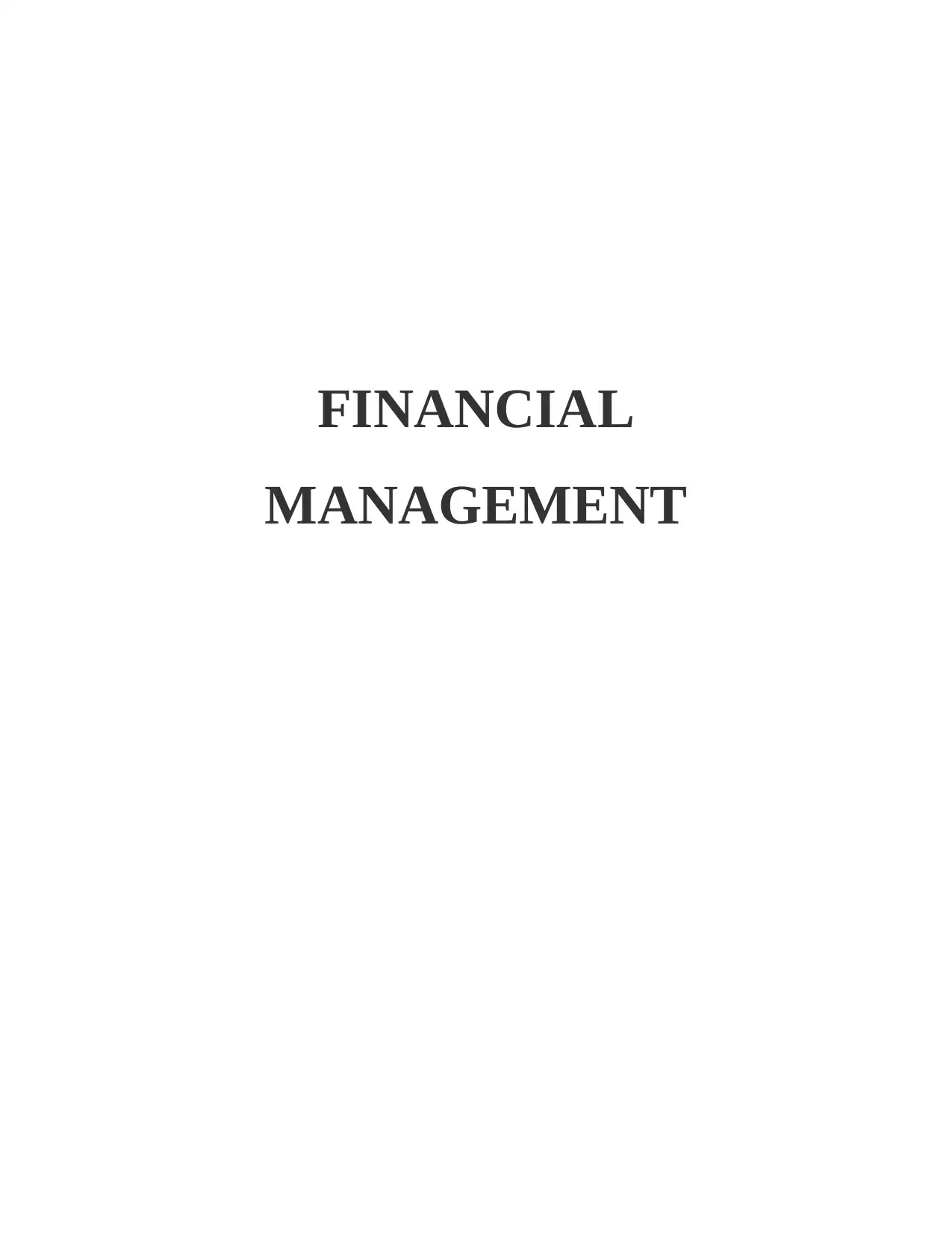
FINANCIAL
MANAGEMENT
MANAGEMENT
Paraphrase This Document
Need a fresh take? Get an instant paraphrase of this document with our AI Paraphraser
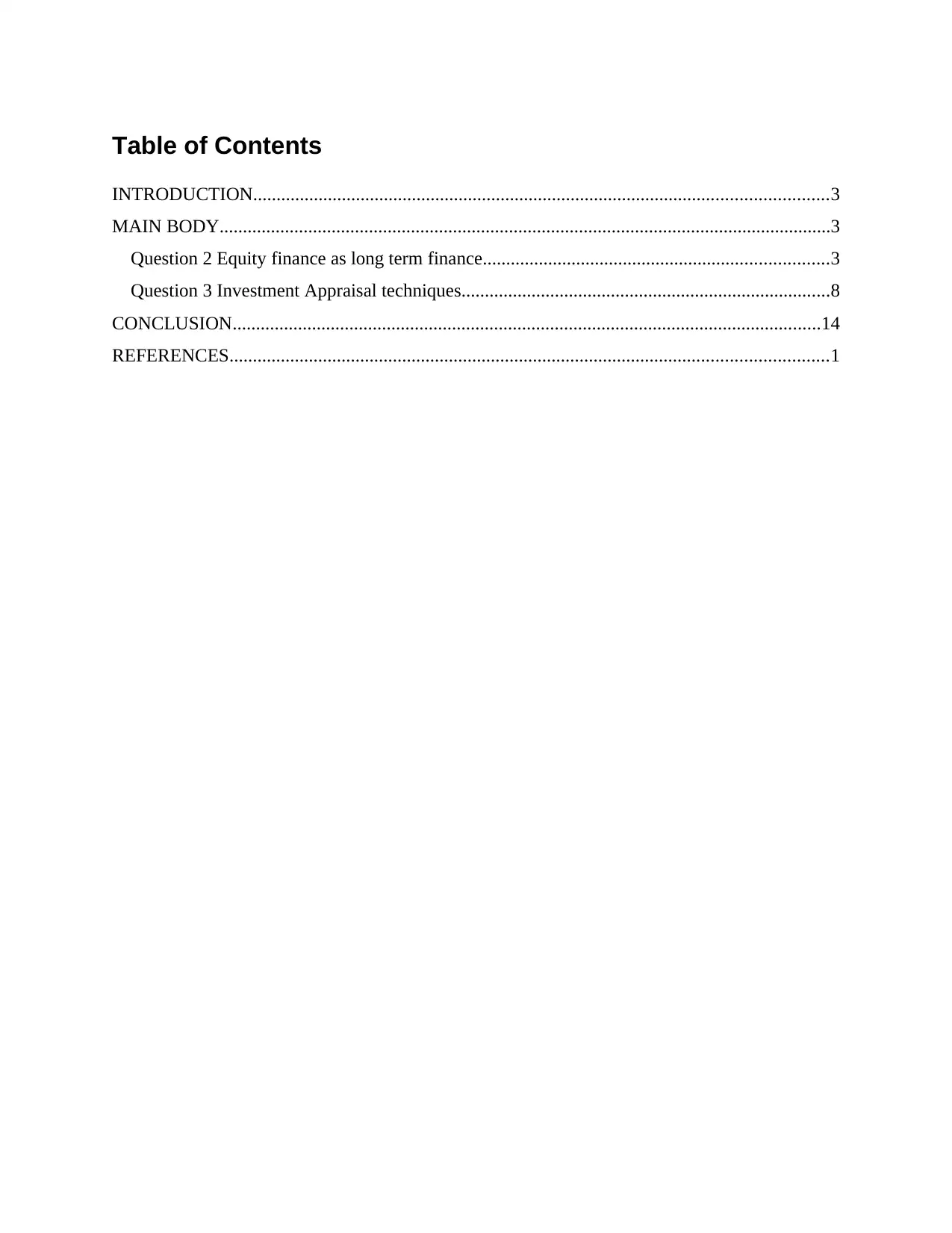
Table of Contents
INTRODUCTION...........................................................................................................................3
MAIN BODY...................................................................................................................................3
Question 2 Equity finance as long term finance..........................................................................3
Question 3 Investment Appraisal techniques...............................................................................8
CONCLUSION..............................................................................................................................14
REFERENCES................................................................................................................................1
INTRODUCTION...........................................................................................................................3
MAIN BODY...................................................................................................................................3
Question 2 Equity finance as long term finance..........................................................................3
Question 3 Investment Appraisal techniques...............................................................................8
CONCLUSION..............................................................................................................................14
REFERENCES................................................................................................................................1
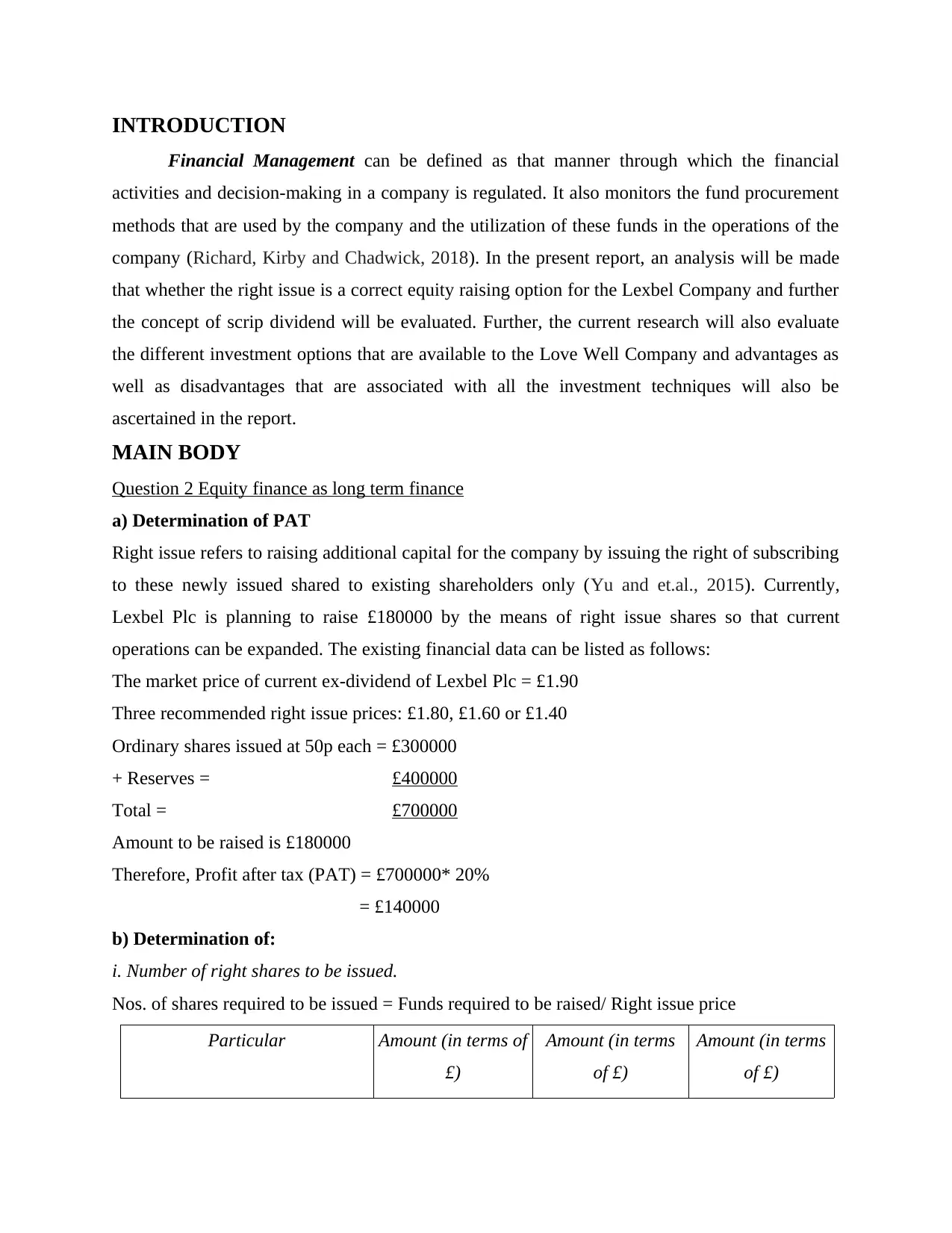
INTRODUCTION
Financial Management can be defined as that manner through which the financial
activities and decision-making in a company is regulated. It also monitors the fund procurement
methods that are used by the company and the utilization of these funds in the operations of the
company (Richard, Kirby and Chadwick, 2018). In the present report, an analysis will be made
that whether the right issue is a correct equity raising option for the Lexbel Company and further
the concept of scrip dividend will be evaluated. Further, the current research will also evaluate
the different investment options that are available to the Love Well Company and advantages as
well as disadvantages that are associated with all the investment techniques will also be
ascertained in the report.
MAIN BODY
Question 2 Equity finance as long term finance
a) Determination of PAT
Right issue refers to raising additional capital for the company by issuing the right of subscribing
to these newly issued shared to existing shareholders only (Yu and et.al., 2015). Currently,
Lexbel Plc is planning to raise £180000 by the means of right issue shares so that current
operations can be expanded. The existing financial data can be listed as follows:
The market price of current ex-dividend of Lexbel Plc = £1.90
Three recommended right issue prices: £1.80, £1.60 or £1.40
Ordinary shares issued at 50p each = £300000
+ Reserves = £400000
Total = £700000
Amount to be raised is £180000
Therefore, Profit after tax (PAT) = £700000* 20%
= £140000
b) Determination of:
i. Number of right shares to be issued.
Nos. of shares required to be issued = Funds required to be raised/ Right issue price
Particular Amount (in terms of
£)
Amount (in terms
of £)
Amount (in terms
of £)
Financial Management can be defined as that manner through which the financial
activities and decision-making in a company is regulated. It also monitors the fund procurement
methods that are used by the company and the utilization of these funds in the operations of the
company (Richard, Kirby and Chadwick, 2018). In the present report, an analysis will be made
that whether the right issue is a correct equity raising option for the Lexbel Company and further
the concept of scrip dividend will be evaluated. Further, the current research will also evaluate
the different investment options that are available to the Love Well Company and advantages as
well as disadvantages that are associated with all the investment techniques will also be
ascertained in the report.
MAIN BODY
Question 2 Equity finance as long term finance
a) Determination of PAT
Right issue refers to raising additional capital for the company by issuing the right of subscribing
to these newly issued shared to existing shareholders only (Yu and et.al., 2015). Currently,
Lexbel Plc is planning to raise £180000 by the means of right issue shares so that current
operations can be expanded. The existing financial data can be listed as follows:
The market price of current ex-dividend of Lexbel Plc = £1.90
Three recommended right issue prices: £1.80, £1.60 or £1.40
Ordinary shares issued at 50p each = £300000
+ Reserves = £400000
Total = £700000
Amount to be raised is £180000
Therefore, Profit after tax (PAT) = £700000* 20%
= £140000
b) Determination of:
i. Number of right shares to be issued.
Nos. of shares required to be issued = Funds required to be raised/ Right issue price
Particular Amount (in terms of
£)
Amount (in terms
of £)
Amount (in terms
of £)
⊘ This is a preview!⊘
Do you want full access?
Subscribe today to unlock all pages.

Trusted by 1+ million students worldwide
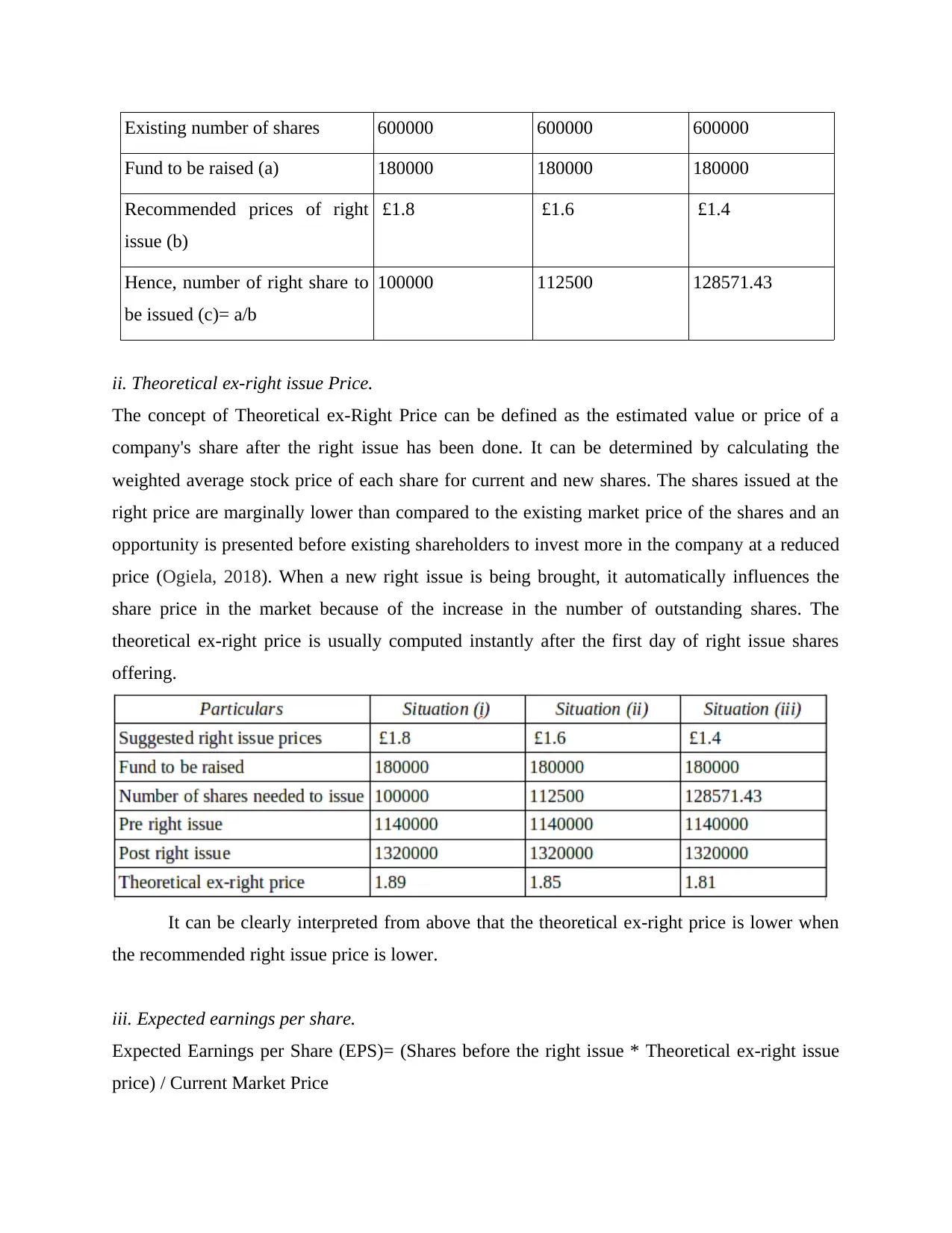
Existing number of shares 600000 600000 600000
Fund to be raised (a) 180000 180000 180000
Recommended prices of right
issue (b)
£1.8 £1.6 £1.4
Hence, number of right share to
be issued (c)= a/b
100000 112500 128571.43
ii. Theoretical ex-right issue Price.
The concept of Theoretical ex-Right Price can be defined as the estimated value or price of a
company's share after the right issue has been done. It can be determined by calculating the
weighted average stock price of each share for current and new shares. The shares issued at the
right price are marginally lower than compared to the existing market price of the shares and an
opportunity is presented before existing shareholders to invest more in the company at a reduced
price (Ogiela, 2018). When a new right issue is being brought, it automatically influences the
share price in the market because of the increase in the number of outstanding shares. The
theoretical ex-right price is usually computed instantly after the first day of right issue shares
offering.
It can be clearly interpreted from above that the theoretical ex-right price is lower when
the recommended right issue price is lower.
iii. Expected earnings per share.
Expected Earnings per Share (EPS)= (Shares before the right issue * Theoretical ex-right issue
price) / Current Market Price
Fund to be raised (a) 180000 180000 180000
Recommended prices of right
issue (b)
£1.8 £1.6 £1.4
Hence, number of right share to
be issued (c)= a/b
100000 112500 128571.43
ii. Theoretical ex-right issue Price.
The concept of Theoretical ex-Right Price can be defined as the estimated value or price of a
company's share after the right issue has been done. It can be determined by calculating the
weighted average stock price of each share for current and new shares. The shares issued at the
right price are marginally lower than compared to the existing market price of the shares and an
opportunity is presented before existing shareholders to invest more in the company at a reduced
price (Ogiela, 2018). When a new right issue is being brought, it automatically influences the
share price in the market because of the increase in the number of outstanding shares. The
theoretical ex-right price is usually computed instantly after the first day of right issue shares
offering.
It can be clearly interpreted from above that the theoretical ex-right price is lower when
the recommended right issue price is lower.
iii. Expected earnings per share.
Expected Earnings per Share (EPS)= (Shares before the right issue * Theoretical ex-right issue
price) / Current Market Price
Paraphrase This Document
Need a fresh take? Get an instant paraphrase of this document with our AI Paraphraser
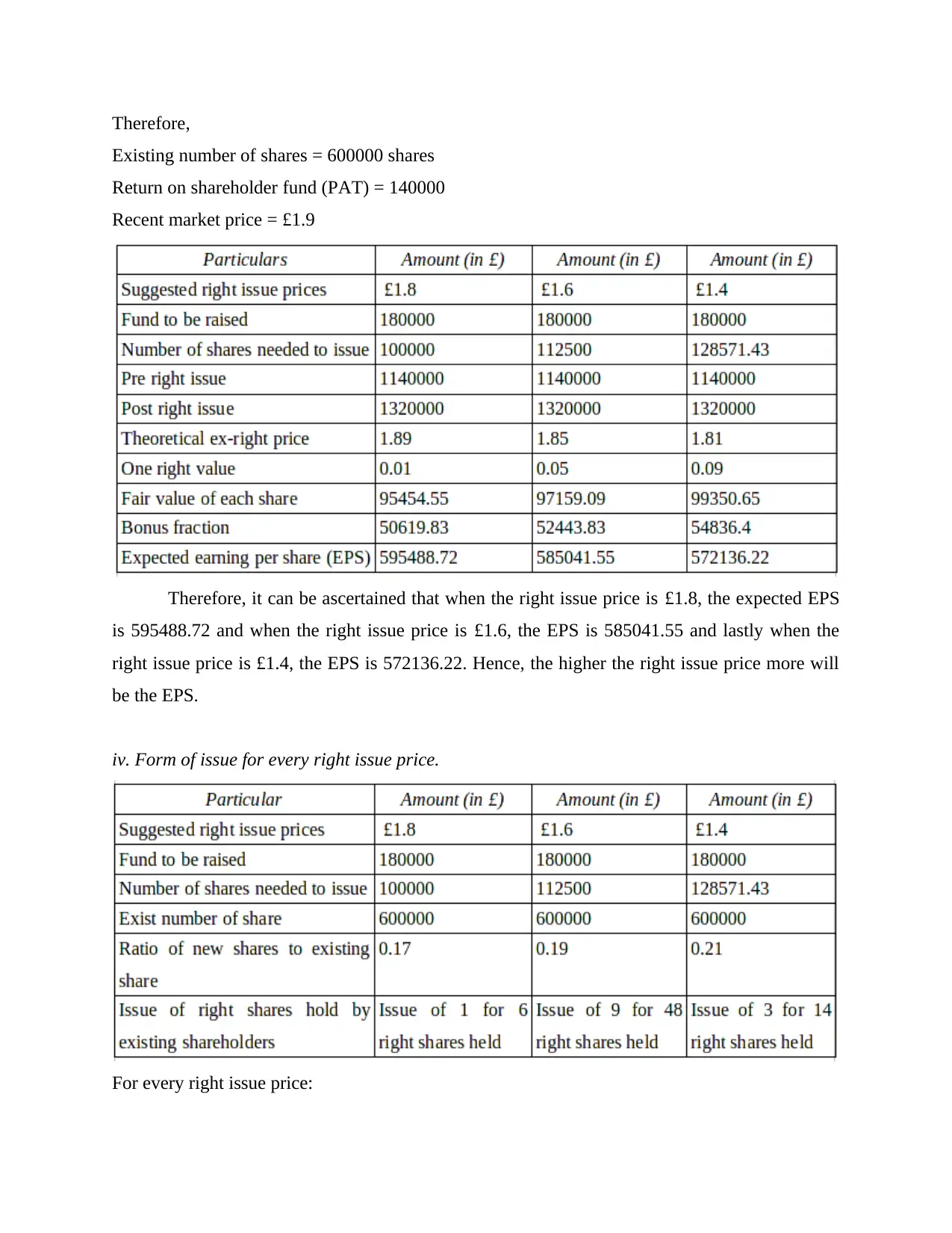
Therefore,
Existing number of shares = 600000 shares
Return on shareholder fund (PAT) = 140000
Recent market price = £1.9
Therefore, it can be ascertained that when the right issue price is £1.8, the expected EPS
is 595488.72 and when the right issue price is £1.6, the EPS is 585041.55 and lastly when the
right issue price is £1.4, the EPS is 572136.22. Hence, the higher the right issue price more will
be the EPS.
iv. Form of issue for every right issue price.
For every right issue price:
Existing number of shares = 600000 shares
Return on shareholder fund (PAT) = 140000
Recent market price = £1.9
Therefore, it can be ascertained that when the right issue price is £1.8, the expected EPS
is 595488.72 and when the right issue price is £1.6, the EPS is 585041.55 and lastly when the
right issue price is £1.4, the EPS is 572136.22. Hence, the higher the right issue price more will
be the EPS.
iv. Form of issue for every right issue price.
For every right issue price:
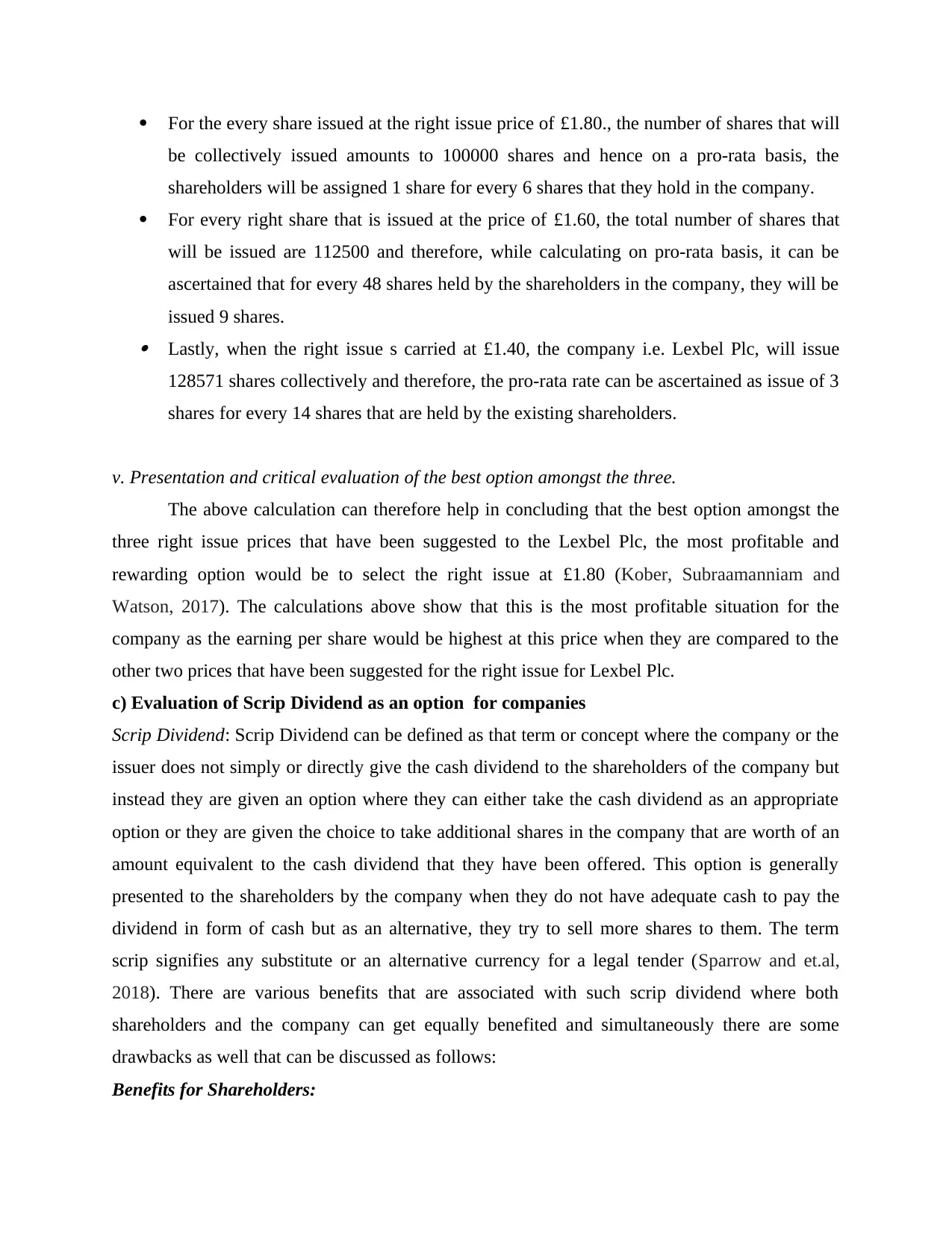
For the every share issued at the right issue price of £1.80., the number of shares that will
be collectively issued amounts to 100000 shares and hence on a pro-rata basis, the
shareholders will be assigned 1 share for every 6 shares that they hold in the company.
For every right share that is issued at the price of £1.60, the total number of shares that
will be issued are 112500 and therefore, while calculating on pro-rata basis, it can be
ascertained that for every 48 shares held by the shareholders in the company, they will be
issued 9 shares. Lastly, when the right issue s carried at £1.40, the company i.e. Lexbel Plc, will issue
128571 shares collectively and therefore, the pro-rata rate can be ascertained as issue of 3
shares for every 14 shares that are held by the existing shareholders.
v. Presentation and critical evaluation of the best option amongst the three.
The above calculation can therefore help in concluding that the best option amongst the
three right issue prices that have been suggested to the Lexbel Plc, the most profitable and
rewarding option would be to select the right issue at £1.80 (Kober, Subraamanniam and
Watson, 2017). The calculations above show that this is the most profitable situation for the
company as the earning per share would be highest at this price when they are compared to the
other two prices that have been suggested for the right issue for Lexbel Plc.
c) Evaluation of Scrip Dividend as an option for companies
Scrip Dividend: Scrip Dividend can be defined as that term or concept where the company or the
issuer does not simply or directly give the cash dividend to the shareholders of the company but
instead they are given an option where they can either take the cash dividend as an appropriate
option or they are given the choice to take additional shares in the company that are worth of an
amount equivalent to the cash dividend that they have been offered. This option is generally
presented to the shareholders by the company when they do not have adequate cash to pay the
dividend in form of cash but as an alternative, they try to sell more shares to them. The term
scrip signifies any substitute or an alternative currency for a legal tender (Sparrow and et.al,
2018). There are various benefits that are associated with such scrip dividend where both
shareholders and the company can get equally benefited and simultaneously there are some
drawbacks as well that can be discussed as follows:
Benefits for Shareholders:
be collectively issued amounts to 100000 shares and hence on a pro-rata basis, the
shareholders will be assigned 1 share for every 6 shares that they hold in the company.
For every right share that is issued at the price of £1.60, the total number of shares that
will be issued are 112500 and therefore, while calculating on pro-rata basis, it can be
ascertained that for every 48 shares held by the shareholders in the company, they will be
issued 9 shares. Lastly, when the right issue s carried at £1.40, the company i.e. Lexbel Plc, will issue
128571 shares collectively and therefore, the pro-rata rate can be ascertained as issue of 3
shares for every 14 shares that are held by the existing shareholders.
v. Presentation and critical evaluation of the best option amongst the three.
The above calculation can therefore help in concluding that the best option amongst the
three right issue prices that have been suggested to the Lexbel Plc, the most profitable and
rewarding option would be to select the right issue at £1.80 (Kober, Subraamanniam and
Watson, 2017). The calculations above show that this is the most profitable situation for the
company as the earning per share would be highest at this price when they are compared to the
other two prices that have been suggested for the right issue for Lexbel Plc.
c) Evaluation of Scrip Dividend as an option for companies
Scrip Dividend: Scrip Dividend can be defined as that term or concept where the company or the
issuer does not simply or directly give the cash dividend to the shareholders of the company but
instead they are given an option where they can either take the cash dividend as an appropriate
option or they are given the choice to take additional shares in the company that are worth of an
amount equivalent to the cash dividend that they have been offered. This option is generally
presented to the shareholders by the company when they do not have adequate cash to pay the
dividend in form of cash but as an alternative, they try to sell more shares to them. The term
scrip signifies any substitute or an alternative currency for a legal tender (Sparrow and et.al,
2018). There are various benefits that are associated with such scrip dividend where both
shareholders and the company can get equally benefited and simultaneously there are some
drawbacks as well that can be discussed as follows:
Benefits for Shareholders:
⊘ This is a preview!⊘
Do you want full access?
Subscribe today to unlock all pages.

Trusted by 1+ million students worldwide
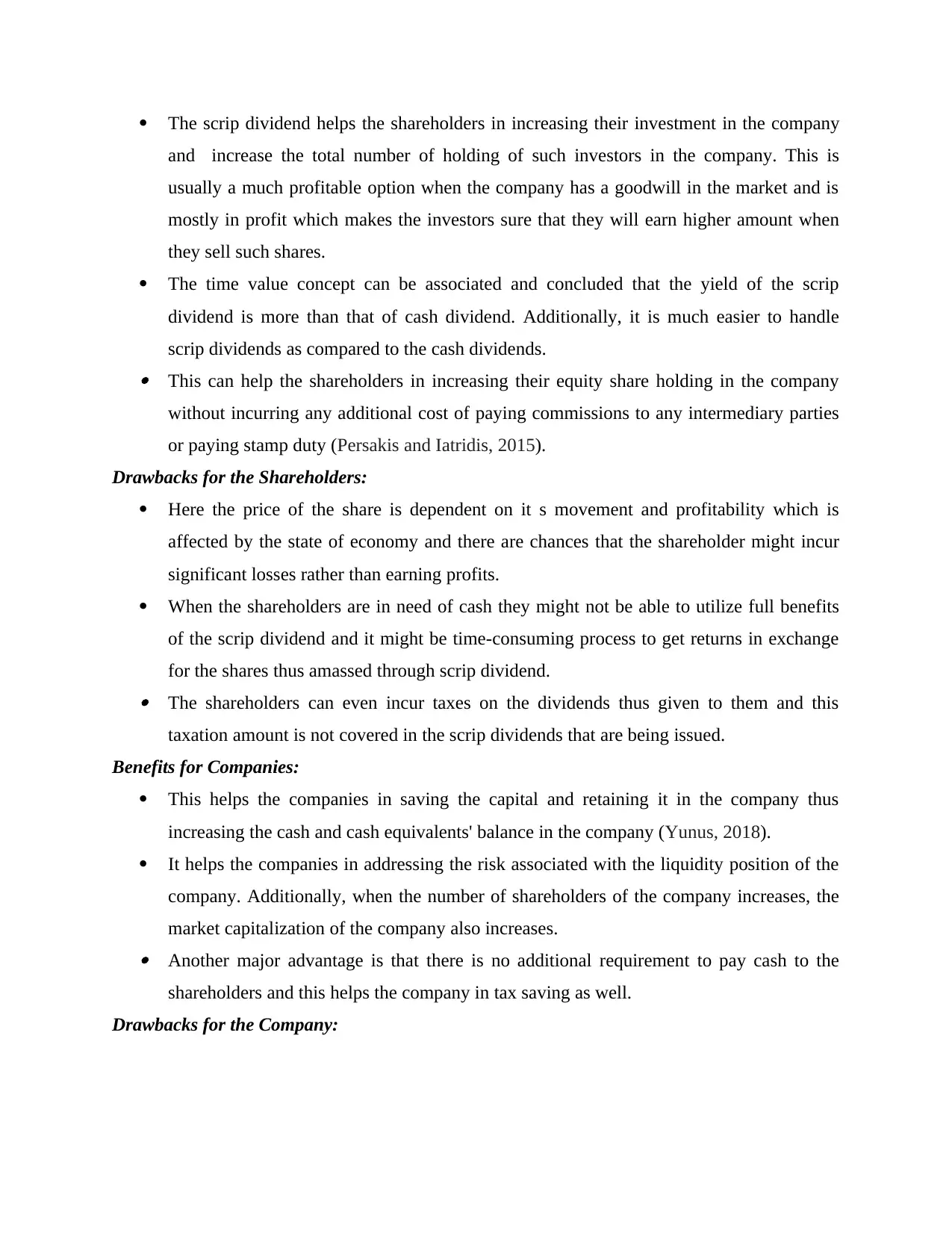
The scrip dividend helps the shareholders in increasing their investment in the company
and increase the total number of holding of such investors in the company. This is
usually a much profitable option when the company has a goodwill in the market and is
mostly in profit which makes the investors sure that they will earn higher amount when
they sell such shares.
The time value concept can be associated and concluded that the yield of the scrip
dividend is more than that of cash dividend. Additionally, it is much easier to handle
scrip dividends as compared to the cash dividends. This can help the shareholders in increasing their equity share holding in the company
without incurring any additional cost of paying commissions to any intermediary parties
or paying stamp duty (Persakis and Iatridis, 2015).
Drawbacks for the Shareholders:
Here the price of the share is dependent on it s movement and profitability which is
affected by the state of economy and there are chances that the shareholder might incur
significant losses rather than earning profits.
When the shareholders are in need of cash they might not be able to utilize full benefits
of the scrip dividend and it might be time-consuming process to get returns in exchange
for the shares thus amassed through scrip dividend. The shareholders can even incur taxes on the dividends thus given to them and this
taxation amount is not covered in the scrip dividends that are being issued.
Benefits for Companies:
This helps the companies in saving the capital and retaining it in the company thus
increasing the cash and cash equivalents' balance in the company (Yunus, 2018).
It helps the companies in addressing the risk associated with the liquidity position of the
company. Additionally, when the number of shareholders of the company increases, the
market capitalization of the company also increases. Another major advantage is that there is no additional requirement to pay cash to the
shareholders and this helps the company in tax saving as well.
Drawbacks for the Company:
and increase the total number of holding of such investors in the company. This is
usually a much profitable option when the company has a goodwill in the market and is
mostly in profit which makes the investors sure that they will earn higher amount when
they sell such shares.
The time value concept can be associated and concluded that the yield of the scrip
dividend is more than that of cash dividend. Additionally, it is much easier to handle
scrip dividends as compared to the cash dividends. This can help the shareholders in increasing their equity share holding in the company
without incurring any additional cost of paying commissions to any intermediary parties
or paying stamp duty (Persakis and Iatridis, 2015).
Drawbacks for the Shareholders:
Here the price of the share is dependent on it s movement and profitability which is
affected by the state of economy and there are chances that the shareholder might incur
significant losses rather than earning profits.
When the shareholders are in need of cash they might not be able to utilize full benefits
of the scrip dividend and it might be time-consuming process to get returns in exchange
for the shares thus amassed through scrip dividend. The shareholders can even incur taxes on the dividends thus given to them and this
taxation amount is not covered in the scrip dividends that are being issued.
Benefits for Companies:
This helps the companies in saving the capital and retaining it in the company thus
increasing the cash and cash equivalents' balance in the company (Yunus, 2018).
It helps the companies in addressing the risk associated with the liquidity position of the
company. Additionally, when the number of shareholders of the company increases, the
market capitalization of the company also increases. Another major advantage is that there is no additional requirement to pay cash to the
shareholders and this helps the company in tax saving as well.
Drawbacks for the Company:
Paraphrase This Document
Need a fresh take? Get an instant paraphrase of this document with our AI Paraphraser
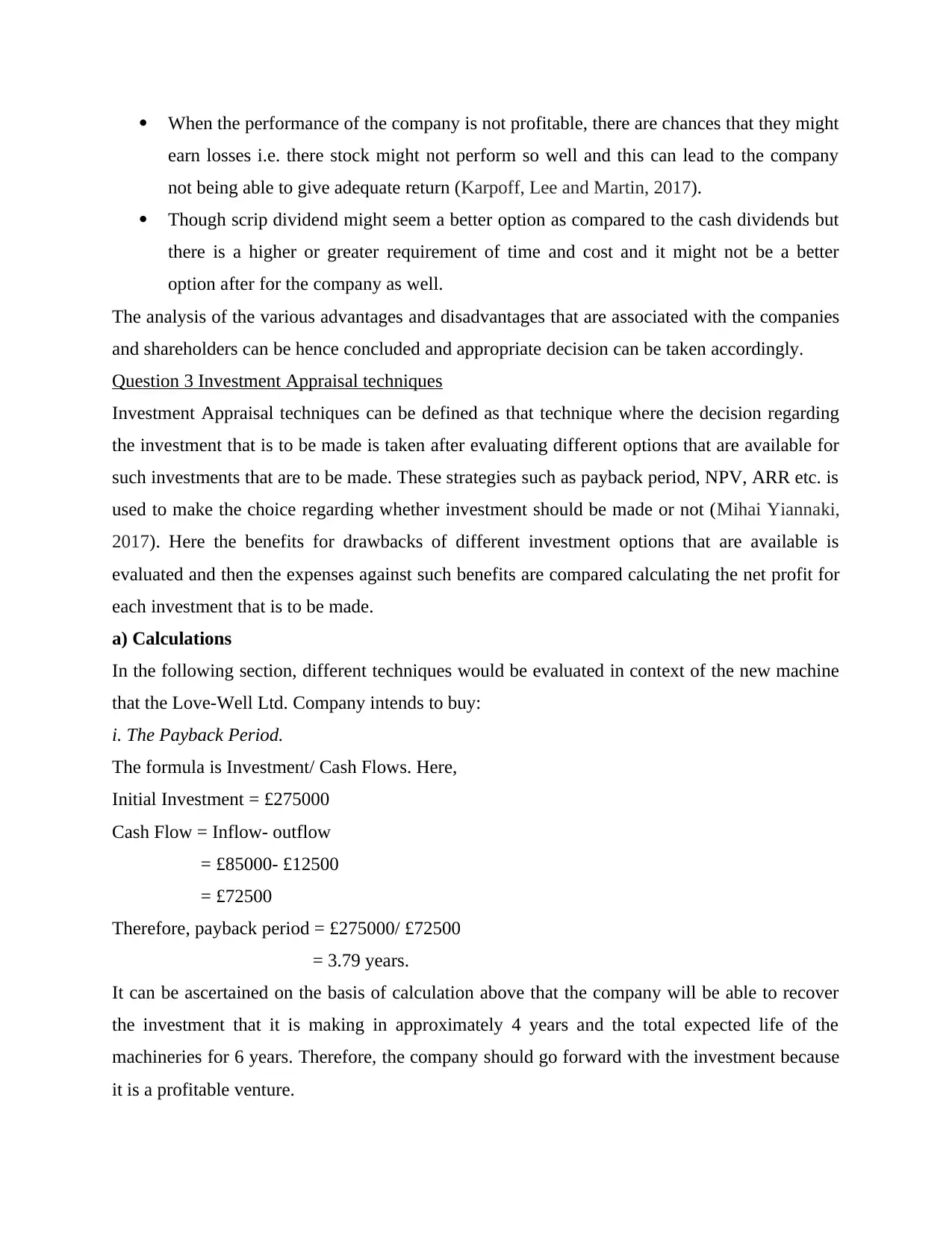
When the performance of the company is not profitable, there are chances that they might
earn losses i.e. there stock might not perform so well and this can lead to the company
not being able to give adequate return (Karpoff, Lee and Martin, 2017).
Though scrip dividend might seem a better option as compared to the cash dividends but
there is a higher or greater requirement of time and cost and it might not be a better
option after for the company as well.
The analysis of the various advantages and disadvantages that are associated with the companies
and shareholders can be hence concluded and appropriate decision can be taken accordingly.
Question 3 Investment Appraisal techniques
Investment Appraisal techniques can be defined as that technique where the decision regarding
the investment that is to be made is taken after evaluating different options that are available for
such investments that are to be made. These strategies such as payback period, NPV, ARR etc. is
used to make the choice regarding whether investment should be made or not (Mihai Yiannaki,
2017). Here the benefits for drawbacks of different investment options that are available is
evaluated and then the expenses against such benefits are compared calculating the net profit for
each investment that is to be made.
a) Calculations
In the following section, different techniques would be evaluated in context of the new machine
that the Love-Well Ltd. Company intends to buy:
i. The Payback Period.
The formula is Investment/ Cash Flows. Here,
Initial Investment = £275000
Cash Flow = Inflow- outflow
= £85000- £12500
= £72500
Therefore, payback period = £275000/ £72500
= 3.79 years.
It can be ascertained on the basis of calculation above that the company will be able to recover
the investment that it is making in approximately 4 years and the total expected life of the
machineries for 6 years. Therefore, the company should go forward with the investment because
it is a profitable venture.
earn losses i.e. there stock might not perform so well and this can lead to the company
not being able to give adequate return (Karpoff, Lee and Martin, 2017).
Though scrip dividend might seem a better option as compared to the cash dividends but
there is a higher or greater requirement of time and cost and it might not be a better
option after for the company as well.
The analysis of the various advantages and disadvantages that are associated with the companies
and shareholders can be hence concluded and appropriate decision can be taken accordingly.
Question 3 Investment Appraisal techniques
Investment Appraisal techniques can be defined as that technique where the decision regarding
the investment that is to be made is taken after evaluating different options that are available for
such investments that are to be made. These strategies such as payback period, NPV, ARR etc. is
used to make the choice regarding whether investment should be made or not (Mihai Yiannaki,
2017). Here the benefits for drawbacks of different investment options that are available is
evaluated and then the expenses against such benefits are compared calculating the net profit for
each investment that is to be made.
a) Calculations
In the following section, different techniques would be evaluated in context of the new machine
that the Love-Well Ltd. Company intends to buy:
i. The Payback Period.
The formula is Investment/ Cash Flows. Here,
Initial Investment = £275000
Cash Flow = Inflow- outflow
= £85000- £12500
= £72500
Therefore, payback period = £275000/ £72500
= 3.79 years.
It can be ascertained on the basis of calculation above that the company will be able to recover
the investment that it is making in approximately 4 years and the total expected life of the
machineries for 6 years. Therefore, the company should go forward with the investment because
it is a profitable venture.
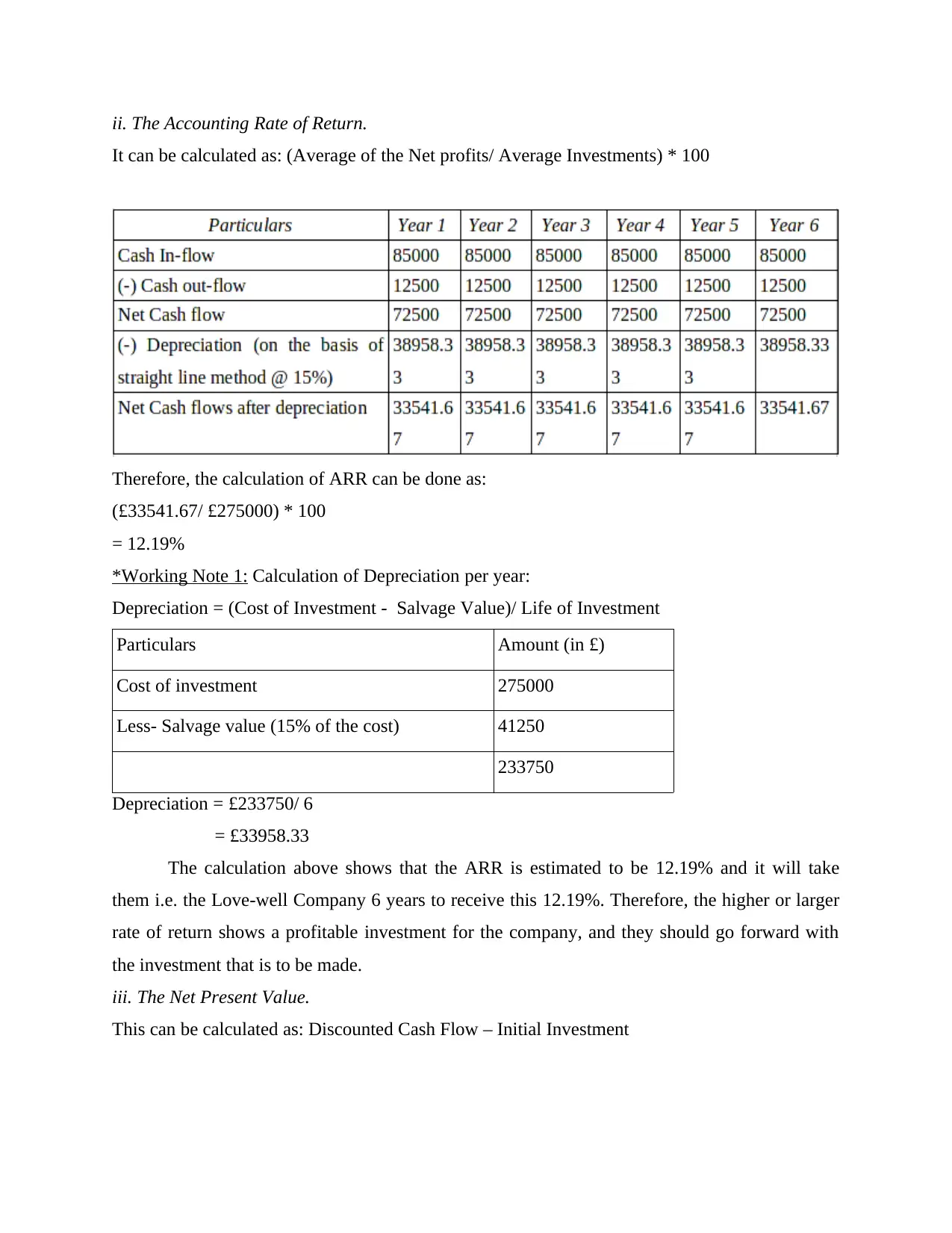
ii. The Accounting Rate of Return.
It can be calculated as: (Average of the Net profits/ Average Investments) * 100
Therefore, the calculation of ARR can be done as:
(£33541.67/ £275000) * 100
= 12.19%
*Working Note 1: Calculation of Depreciation per year:
Depreciation = (Cost of Investment - Salvage Value)/ Life of Investment
Particulars Amount (in £)
Cost of investment 275000
Less- Salvage value (15% of the cost) 41250
233750
Depreciation = £233750/ 6
= £33958.33
The calculation above shows that the ARR is estimated to be 12.19% and it will take
them i.e. the Love-well Company 6 years to receive this 12.19%. Therefore, the higher or larger
rate of return shows a profitable investment for the company, and they should go forward with
the investment that is to be made.
iii. The Net Present Value.
This can be calculated as: Discounted Cash Flow – Initial Investment
It can be calculated as: (Average of the Net profits/ Average Investments) * 100
Therefore, the calculation of ARR can be done as:
(£33541.67/ £275000) * 100
= 12.19%
*Working Note 1: Calculation of Depreciation per year:
Depreciation = (Cost of Investment - Salvage Value)/ Life of Investment
Particulars Amount (in £)
Cost of investment 275000
Less- Salvage value (15% of the cost) 41250
233750
Depreciation = £233750/ 6
= £33958.33
The calculation above shows that the ARR is estimated to be 12.19% and it will take
them i.e. the Love-well Company 6 years to receive this 12.19%. Therefore, the higher or larger
rate of return shows a profitable investment for the company, and they should go forward with
the investment that is to be made.
iii. The Net Present Value.
This can be calculated as: Discounted Cash Flow – Initial Investment
⊘ This is a preview!⊘
Do you want full access?
Subscribe today to unlock all pages.

Trusted by 1+ million students worldwide
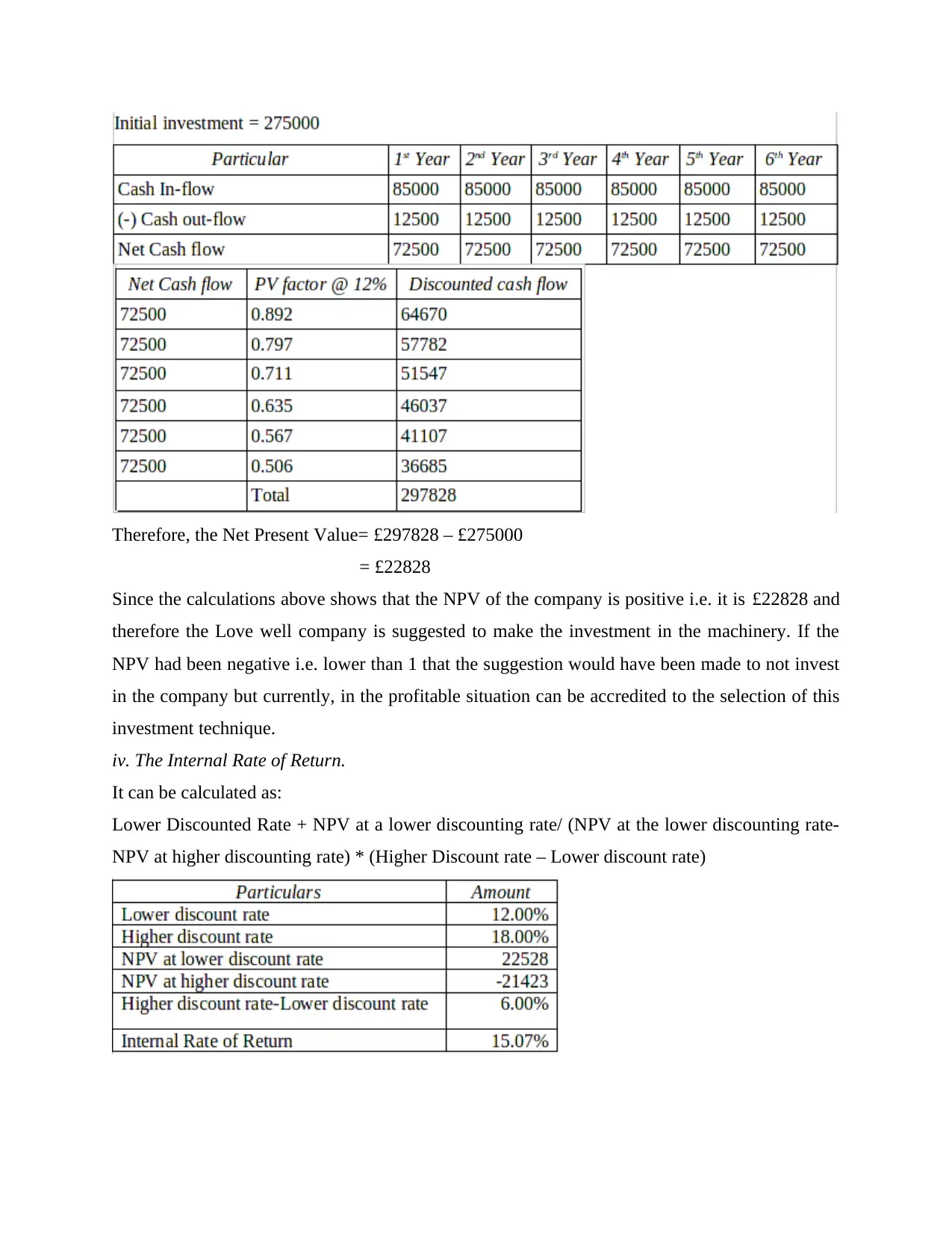
Therefore, the Net Present Value= £297828 – £275000
= £22828
Since the calculations above shows that the NPV of the company is positive i.e. it is £22828 and
therefore the Love well company is suggested to make the investment in the machinery. If the
NPV had been negative i.e. lower than 1 that the suggestion would have been made to not invest
in the company but currently, in the profitable situation can be accredited to the selection of this
investment technique.
iv. The Internal Rate of Return.
It can be calculated as:
Lower Discounted Rate + NPV at a lower discounting rate/ (NPV at the lower discounting rate-
NPV at higher discounting rate) * (Higher Discount rate – Lower discount rate)
= £22828
Since the calculations above shows that the NPV of the company is positive i.e. it is £22828 and
therefore the Love well company is suggested to make the investment in the machinery. If the
NPV had been negative i.e. lower than 1 that the suggestion would have been made to not invest
in the company but currently, in the profitable situation can be accredited to the selection of this
investment technique.
iv. The Internal Rate of Return.
It can be calculated as:
Lower Discounted Rate + NPV at a lower discounting rate/ (NPV at the lower discounting rate-
NPV at higher discounting rate) * (Higher Discount rate – Lower discount rate)
Paraphrase This Document
Need a fresh take? Get an instant paraphrase of this document with our AI Paraphraser
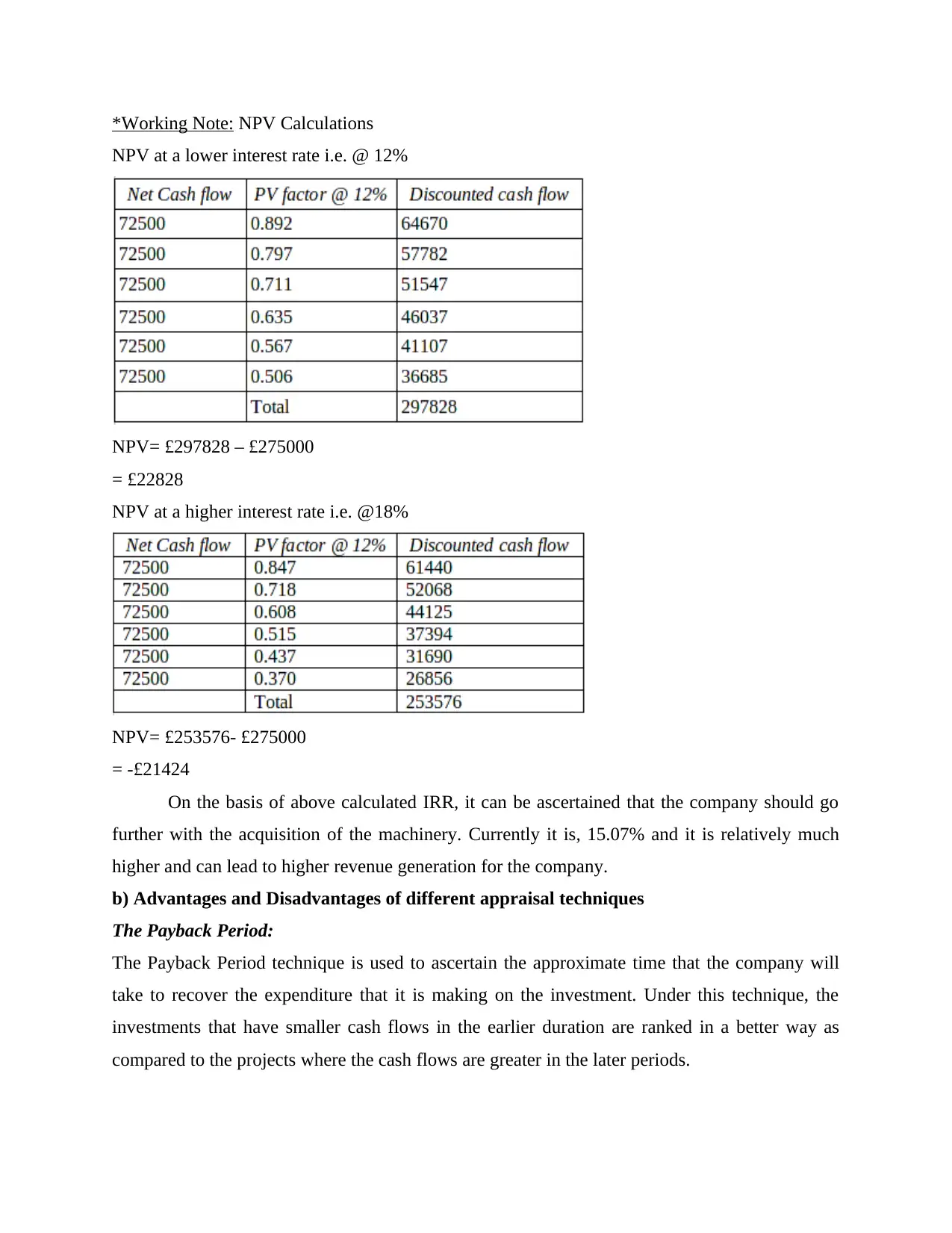
*Working Note: NPV Calculations
NPV at a lower interest rate i.e. @ 12%
NPV= £297828 – £275000
= £22828
NPV at a higher interest rate i.e. @18%
NPV= £253576- £275000
= -£21424
On the basis of above calculated IRR, it can be ascertained that the company should go
further with the acquisition of the machinery. Currently it is, 15.07% and it is relatively much
higher and can lead to higher revenue generation for the company.
b) Advantages and Disadvantages of different appraisal techniques
The Payback Period:
The Payback Period technique is used to ascertain the approximate time that the company will
take to recover the expenditure that it is making on the investment. Under this technique, the
investments that have smaller cash flows in the earlier duration are ranked in a better way as
compared to the projects where the cash flows are greater in the later periods.
NPV at a lower interest rate i.e. @ 12%
NPV= £297828 – £275000
= £22828
NPV at a higher interest rate i.e. @18%
NPV= £253576- £275000
= -£21424
On the basis of above calculated IRR, it can be ascertained that the company should go
further with the acquisition of the machinery. Currently it is, 15.07% and it is relatively much
higher and can lead to higher revenue generation for the company.
b) Advantages and Disadvantages of different appraisal techniques
The Payback Period:
The Payback Period technique is used to ascertain the approximate time that the company will
take to recover the expenditure that it is making on the investment. Under this technique, the
investments that have smaller cash flows in the earlier duration are ranked in a better way as
compared to the projects where the cash flows are greater in the later periods.
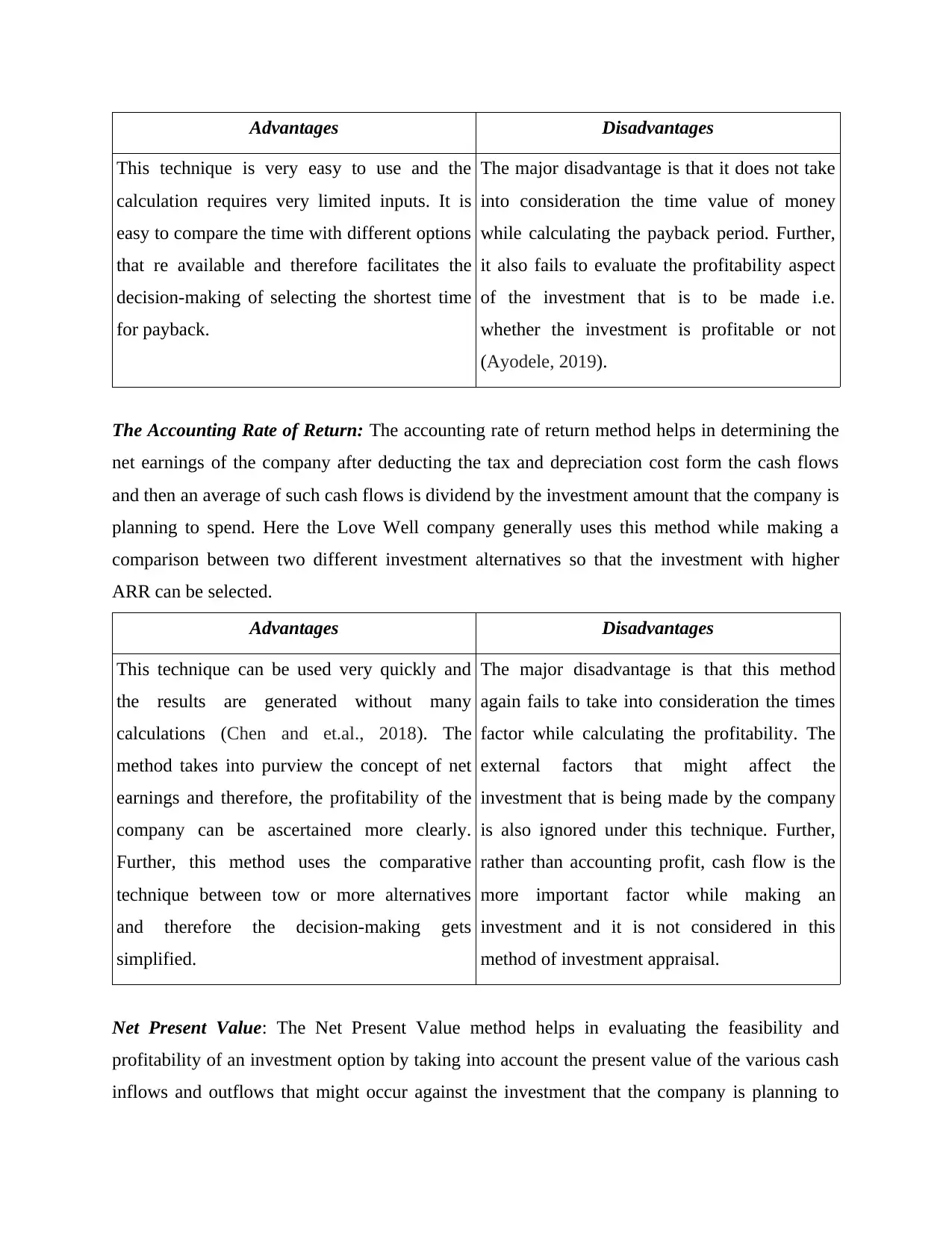
Advantages Disadvantages
This technique is very easy to use and the
calculation requires very limited inputs. It is
easy to compare the time with different options
that re available and therefore facilitates the
decision-making of selecting the shortest time
for payback.
The major disadvantage is that it does not take
into consideration the time value of money
while calculating the payback period. Further,
it also fails to evaluate the profitability aspect
of the investment that is to be made i.e.
whether the investment is profitable or not
(Ayodele, 2019).
The Accounting Rate of Return: The accounting rate of return method helps in determining the
net earnings of the company after deducting the tax and depreciation cost form the cash flows
and then an average of such cash flows is dividend by the investment amount that the company is
planning to spend. Here the Love Well company generally uses this method while making a
comparison between two different investment alternatives so that the investment with higher
ARR can be selected.
Advantages Disadvantages
This technique can be used very quickly and
the results are generated without many
calculations (Chen and et.al., 2018). The
method takes into purview the concept of net
earnings and therefore, the profitability of the
company can be ascertained more clearly.
Further, this method uses the comparative
technique between tow or more alternatives
and therefore the decision-making gets
simplified.
The major disadvantage is that this method
again fails to take into consideration the times
factor while calculating the profitability. The
external factors that might affect the
investment that is being made by the company
is also ignored under this technique. Further,
rather than accounting profit, cash flow is the
more important factor while making an
investment and it is not considered in this
method of investment appraisal.
Net Present Value: The Net Present Value method helps in evaluating the feasibility and
profitability of an investment option by taking into account the present value of the various cash
inflows and outflows that might occur against the investment that the company is planning to
This technique is very easy to use and the
calculation requires very limited inputs. It is
easy to compare the time with different options
that re available and therefore facilitates the
decision-making of selecting the shortest time
for payback.
The major disadvantage is that it does not take
into consideration the time value of money
while calculating the payback period. Further,
it also fails to evaluate the profitability aspect
of the investment that is to be made i.e.
whether the investment is profitable or not
(Ayodele, 2019).
The Accounting Rate of Return: The accounting rate of return method helps in determining the
net earnings of the company after deducting the tax and depreciation cost form the cash flows
and then an average of such cash flows is dividend by the investment amount that the company is
planning to spend. Here the Love Well company generally uses this method while making a
comparison between two different investment alternatives so that the investment with higher
ARR can be selected.
Advantages Disadvantages
This technique can be used very quickly and
the results are generated without many
calculations (Chen and et.al., 2018). The
method takes into purview the concept of net
earnings and therefore, the profitability of the
company can be ascertained more clearly.
Further, this method uses the comparative
technique between tow or more alternatives
and therefore the decision-making gets
simplified.
The major disadvantage is that this method
again fails to take into consideration the times
factor while calculating the profitability. The
external factors that might affect the
investment that is being made by the company
is also ignored under this technique. Further,
rather than accounting profit, cash flow is the
more important factor while making an
investment and it is not considered in this
method of investment appraisal.
Net Present Value: The Net Present Value method helps in evaluating the feasibility and
profitability of an investment option by taking into account the present value of the various cash
inflows and outflows that might occur against the investment that the company is planning to
⊘ This is a preview!⊘
Do you want full access?
Subscribe today to unlock all pages.

Trusted by 1+ million students worldwide
1 out of 16
Related Documents
Your All-in-One AI-Powered Toolkit for Academic Success.
+13062052269
info@desklib.com
Available 24*7 on WhatsApp / Email
![[object Object]](/_next/static/media/star-bottom.7253800d.svg)
Unlock your academic potential
Copyright © 2020–2025 A2Z Services. All Rights Reserved. Developed and managed by ZUCOL.





